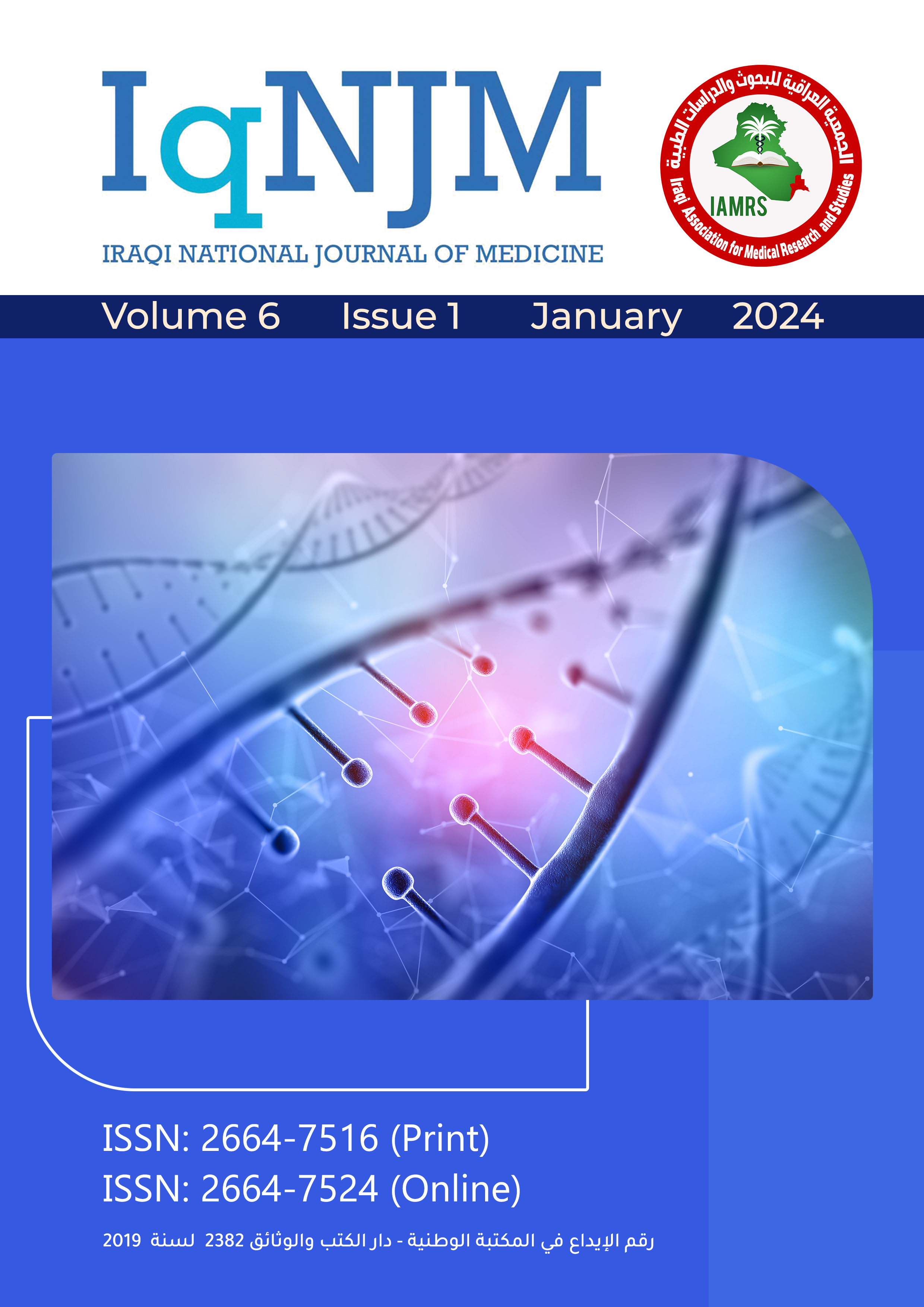Types of bacteria among pediatric oncology patients in Basra
Main Article Content
Keywords
pediatric oncology, neutropenia, fever, antibiotic resistance, culture, bacteria
Abstract
Background: Infectious agents are the main factor that causes children suffering from cancer to be more susceptible
to treatment failure. They complicate their course of therapy, thus shortening their lives. Aim: To find out the most
notorious pathogen affecting pediatric malignancy in Basra Children Specialty Hospital to provide the best
antimicrobial therapy choice and map out the future empirical therapy. Methods: One hundred and ten pediatric
oncology patients in the pediatric hemato-oncology unit aged 16 years and less were involved in this retrospective
study from March 1, 2021 to the end of February 2022. Different types of culture tests were taken in various stages
of malignancy besides other investigations, including CBC, RFT, LFT and imaging. According to studies, these were
important, since they help to spot the infection even if the culture was negative. Results: Acute Lymphoblastic
Leukemia was the main malignancy involved in this study (42.7%). 73.6% of patients were aged 1–10 years, 58% were
male, 62% were from Basra, and almost 2/3rd of them were from the periphery. Gram-positive bacteria represented
55.5% of the cases; Staphylococcus hemolytic and Staphylococcus hominine were mainly found, followed by E. coli,
which was the major gram-negative bacteria, which seemed to manifest during induction and relapse stages. These
were more likely to have a different type of antibiotic resistance to ESBL, CRE, and MRSA. Conclusions: Pediatric
oncology patients with fever, neutropenia, and/or mucositis were more infected by gram-positive bacteria. The
presence of bacteremia tends to be more critical during induction and relapse stages, as this may increase fatality.
These deaths can be prevented using strict infection control measures, with the consequence of intimidating effect
of the development of antibiotic resistance for existing patients as well as future patients.
References
F. Isolation, identification, and profile of antibiotic resistance of
bacteria in patients with cancer. Iranian Journal of Medical
Sciences. 2010 Jun 1;35(2):109-15.
2. Worku M, Belay G, Tigabu A. Bacterial profile and antimicrobial
susceptibility patterns in cancer patients. PloS one. 2022 Apr
15;17(4): e0266919.
3. Mattei D, Baretta V, Mazzariol A, Maccacaro L, Balter R, Zaccaron
A et al. Characteristics and Outcomes of Bloodstream Infections
in a Tertiary-Care PediatricHematology–Oncology Unit: A 10-Year
Study. Journal of Clinical Medicine. 2022 Feb 8;11(3):880.
4. Ozdemir ZC, Kar YD, Kasaci B, Bor O. Etiological causes and
prognosis in children with neutropenia. Northern Clinics of
İstanbul. 2021;8(3):236.
5. Wang C, Pan R, Wan X, Tan Y, Xu L, Ho CS et al. Immediate
psychological responses and associated factors during the initial
stage of the 2019 coronavirus disease (COVID-19) epidemic
among the general population in China. International journal of
environmental research and public health. 2020 Jan;17(5):1729.
6. Garrido MM, Garrido RQ, Cunha TN, Ehrlich S, Martins IS.
Comparison of epidemiological, clinical, and microbiological
characteristics of bloodstream infection in children with solid
tumors and hematological malignancies. Epidemiology and
Infection. 2019;147.
7. Gustinetti G, Mikulska M. Bloodstream infections in neutropenic
cancer patients: a practical update. Virulence. 2016 Apr
2;7(3):280-97.
8. Arman G, Zeyad M, Qindah B, Abu Taha A, Amer R, Abutaha S et
al. Frequency of microbial isolates and antimicrobial resistance
pattern in patients with hematological malignancies: a crosssectional study from Palestine. BMC Infectious Diseases. 2022
Dec;22(1):1-2.
9. Vázquez-López R, Rivero Rojas O, Ibarra Moreno A, Urrutia Favila
JE, Peña Barreto A et al. Antibiotic-resistant septicemia in
pediatric oncology patients associated with post-therapeutic
neutropenic fever. Antibiotics. 2019 Jul 30;8(3):106.
10. Freifeld AG, Bow EJ, Sepkowitz KA, Boeckh MJ, Ito JI, Mullen CA et
al. Clinical practice guideline for using antimicrobial agents in
neutropenic patients with cancer: 2010 update by the Infectious
Diseases Society of America. Clinical infectious diseases. 2011 Feb
15;52(4):e56-93.
11. Al-Mulla NA, Taj-Aldeen SJ, El Shafie S, Janahi M, Al-Nasser AA,
Chandra P. Bacterial bloodstream infections and antimicrobial
susceptibility pattern in pediatric hematology/oncology patients
after anticancer chemotherapy. Infection and drug resistance.
2014; 7:289.
12. Al-Rawazq HS, Mohammed AK, Hussein AA. Microbiological
Identification of Bacteria with Leukemic Children. Journal of Pure
and Applied Microbiology. 2022 Mar 1;16(1):394-402.
13. Kuo FC, Wang SM, Shen CF, Ma YJ, Ho TS, Chen JS et al.
Bloodstream infections in pediatric patients with acute Leukemia:
Emphasis on gram-negative bacteria infections. Journal of
Microbiology, Immunology, and Infection. 2017 Aug 1;50(4):507-
13.
14. Uso RS, Taher CA. Bacterial profile, antibiotic resistance patterns,
and associated factors among malignant hematological patients
in Erbil city. Zanco Journal of Pure and Applied Sciences. 2021 Jun
20;33(3):70-84.
15. Boeriu E, Borda A, Vulcanescu DD, Sarbu V, Arghirescu ST, Ciorica
O et al. Diagnosis and Management of Febrile Neutropenia in
Pediatric Oncology Patients—A Systematic Review. Diagnostics
[Internet] 2022;12(8):1800. Available from:
http://dx.doi.org/10.3390/diagnostics12081800
16. Kara TT, Erat T, Yahşi A, Özdemir H, İLERİ DT, Ince E et al.
Bloodstream infections in pediatric hematology/oncology
patients: Six years? Experience of a single center in Turkey.
Turkish Journal of Medical Sciences. 2019;49(4):1157-64.
17. Al-Zubaidy AS,Jumaa SS, Radhi QR, Bacteriological study of febrile
neutropenia in patients with hematological malignancies in
Baghdad Teaching Hospital. The Iraqi Postgraduate Medical
Journal.2020;19 (1):68-73.
18. VonKnorring N, Nana T, Chibabhai V. Cumulative antimicrobial
susceptibility data for a tertiary-level pediatric oncology unit in
Johannesburg, South Africa. S. Afr. j. Oncol. 2019;3(0), a65.
https://doi.org/10.4102/ sajo. v3i0.65.
19. Levene I, Castagnola E, Haeusler GM. Antibiotic-resistant gramnegative bloodstream infections in children with cancer: A review
of epidemiology, risk factors, and outcome. The Pediatric
infectious disease journal. 2018 May 1;37(5):495-8.
20. Rabirad N, Mohammadpoor M, Lari AR, Shojaie A, Bayat R,
Alebouyeh M. Antimicrobial susceptibility patterns of the gramnegative bacteria isolated from septicemia in Children's Medical
Center, Tehran, Iran. Journal of preventive medicine and hygiene.
2014 Mar;55(1):23.
21. Mvalo T, Eley B, Bamford C, Stanley C, Chagomerana M, Hendricks
M et al. Bloodstream infections in red cross war memorial
Children's oncology patients Hospital, Cape Town, from 2012 to
2014. International Journal of Infectious Diseases. 2018 Dec
1;77:40-7.


